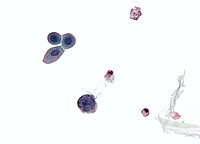
Photo from wikipedia
Background A number of cerebral manifestations are associated with JC polyomavirus (JCPyV) which are diagnosed by detection of JCPyV in cerebrospinal fluid (CSF), often with the support of cerebral imaging.… Click to show full abstract
Background A number of cerebral manifestations are associated with JC polyomavirus (JCPyV) which are diagnosed by detection of JCPyV in cerebrospinal fluid (CSF), often with the support of cerebral imaging. Here we present an unusual case of a kidney transplant patient presenting with progressive neurological deterioration attributed to JCPyV encephalopathy. Methods Quantitative polymerase chain reaction JCPyV was used prospectively and retrospectively to track the viral load within the patient blood, urine, CSF, and kidney sections. A JCPyV VP1 enzyme-linked immunosorbent assay was used to measure patient and donor antibody titers. Immunohistochemical staining was used to identify active JCPyV infection within the kidney allograft. Results JC polyomavirus was detected in the CSF at the time of presentation. JC polyomavirus was not detected in pretransplant serum, however viral loads increased with time, peaking during the height of the neurological symptoms (1.5E9 copies/mL). No parenchymal brain lesions were evident on imaging, but transient cerebral venous sinus thrombosis was present. Progressive decline in neurological function necessitated immunotherapy cessation and allograft removal, which led to decreasing serum viral loads and resolution of neurological symptoms. JC polyomavirus was detected within the graft's collecting duct cells using quantitative polymerase chain reaction and immunohistochemical staining. The patient was JCPyV naive pretransplant, but showed high antibody titers during the neurological symptoms, with the IgM decrease paralleling the viral load after graft removal. Conclusions We report a case of atypical JCPyV encephalopathy associated with cerebral venous sinus thrombosis and disseminated primary JCPyV infection originating from the kidney allograft. Clinical improvement followed removal of the allograft and cessation of immunosuppression.
Journal Title: Transplantation
Year Published: 2017
Link to full text (if available)
Share on Social Media: Sign Up to like & get
recommendations!